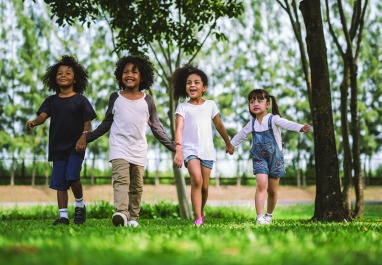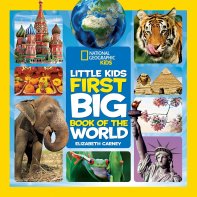When we think of geography, we tend to imagine maps, globes, and atlases. While these tools are relevant to learning about place, the study of geography involves so much more. For children, geography involves developing a sense of place by learning about the natural environment and understanding their relationship to it. It goes without saying that children are most in touch with the places where they live.
According to research on social studies in early childhood, geographic experiences support children’s social and emotional development by allowing them to foster relationships, use their senses, and make memories. When children are given opportunities to explore a place over time, they begin to understand how places can change and the affect humans have on them. Support children’s geographic explorations with these 7 activities:
Photograph or video record walks. It’s customary in preschool settings to take children for walks. While a walk itself fosters an understanding of place, you can extend this experience by photographing it or recording it on video. Help children notice buildings, landmarks, and nature  items on your walk. Photograph or record items of interest and the children as they observe them. When you return to your setting, view the images or video together. Invite children to recall the steps it took to get from one place to another. Encourage the use of positional terms—”We walked under a bridge,” “We stepped over puddles,” or “We turned onto the street with the grocery store.” Place the images in a photo album for children to observe on their own time. To extend this activity, choose one destination and return to it once each season to see how it changes throughout the year. Support children in recalling details by taking photographs and drawing in journals.
items on your walk. Photograph or record items of interest and the children as they observe them. When you return to your setting, view the images or video together. Invite children to recall the steps it took to get from one place to another. Encourage the use of positional terms—”We walked under a bridge,” “We stepped over puddles,” or “We turned onto the street with the grocery store.” Place the images in a photo album for children to observe on their own time. To extend this activity, choose one destination and return to it once each season to see how it changes throughout the year. Support children in recalling details by taking photographs and drawing in journals.
Draw and observe items from different angles. There is a fair amount of perspective and spatial awareness involved in geographic thinking. Support children in developing these skills by choosing an object or piece of furniture in your room and inviting children to draw it from different angles. For example, you may choose a reading chair. Invite some children to draw the chair from the front and close up and others to draw it from the side and further away. Compare the images and talk about how they are different. Such activities will help children think about distance and location and develop a language for describing these things.
Retell stories using a flannel board or cutouts. Geography involves an understanding of place and time. When children are asked to retell stories, especially with the use of props, they are creating a story map through which they explore the concepts of place and time. Choose a favorite story and create felt pieces for children to retell the story using a flannel board, or offer cutouts for the children to manipulate. Support children in choosing accurate verbs and positional words when necessary. Help children understand that the felt pieces/cutouts are symbols, much like those they would encounter on maps.
Sort animals by habitat. Maps are comprised of water and land formations. Gather several toy animals and a large map. Invite children to sit in a circle and place the animals and map in the center. Explain to children which parts of the map represent land and which parts water. Challenge children one at time to choose an animal and decide if it lives on land or in the water and place it on the correct part of the map.
Maps are comprised of water and land formations. Gather several toy animals and a large map. Invite children to sit in a circle and place the animals and map in the center. Explain to children which parts of the map represent land and which parts water. Challenge children one at time to choose an animal and decide if it lives on land or in the water and place it on the correct part of the map.
Study symbols. Maps contain symbols, as do the physical spaces in which we travel. As you’re out and about with children, help them notice symbols—a flashing hand on the crosswalk sign, a sign with a bus on it to designate an area as a bus stop, a sign with a person reading to signal a library is nearby, etc. Talk with children about how symbols often give us information without using words. Make a list of symbols the children know. Offer images of new ones for the children to learn.
Go on a treasure hunt. Visit with children about the prominent features of one room in your setting or small space outside. As they talk, ask them to describe where different items are located. Begin using their words and descriptions as directions for making a map of the space. Take time when the children are preoccupied to hide some items throughout the area they described. Later, place Xs on the drawing where you hid items and challenge children to use the drawing as map to find the items.
Visit with children about the prominent features of one room in your setting or small space outside. As they talk, ask them to describe where different items are located. Begin using their words and descriptions as directions for making a map of the space. Take time when the children are preoccupied to hide some items throughout the area they described. Later, place Xs on the drawing where you hid items and challenge children to use the drawing as map to find the items.
Create “Place Baskets.” Finally, support children in learning about new places (even if they’re in the same town or city) by creating Place Baskets. Place Baskets enable children to think about places, who and what lives there, and develop a relationship with the physical environment. Choose a simple basket and fill it with a variety of materials that describe a place. For example, maybe your city has a zoo. Place a few toy animals in the basket, along with an animal puzzle, pictures of the zoo, a zoo map, and a container of playdough. Invite children to explore the basket. They may open the map and attempt to place the animals on the part of the map that signifies their home, they might match the toy animals to the pictures, or perhaps they will make animal tracks in the playdough. You may even want to extend this activity by inviting families to submit items from places they’ve visited to develop Place Baskets unique to each child that extend beyond your setting and the place where you live.
Books 
- National Geographic: Little Kids First Big Book of the World by Elizabeth Carney
- A Walk in the Forest by Maria Dek
- My House / Mi Casa by Rebecca Emberley
- My Map Book by Sara Fanelli
- As the Crow Flies: A First Book of Maps by Gail Hartman
- Rosie’s Walk by Pat Hutchins
- This Is How We Do It: One Day in the Lives of Seven Kids from Around the World by Matt Lamothe
- Welcome Home, Bear: A Book of Animal Habitats by Il Sung Na
- National Geographic Kids: My First Atlas of the World by National Geographic Kids
- Me on the Map by Joan Sweeney
Online Resources
Back to blog listing